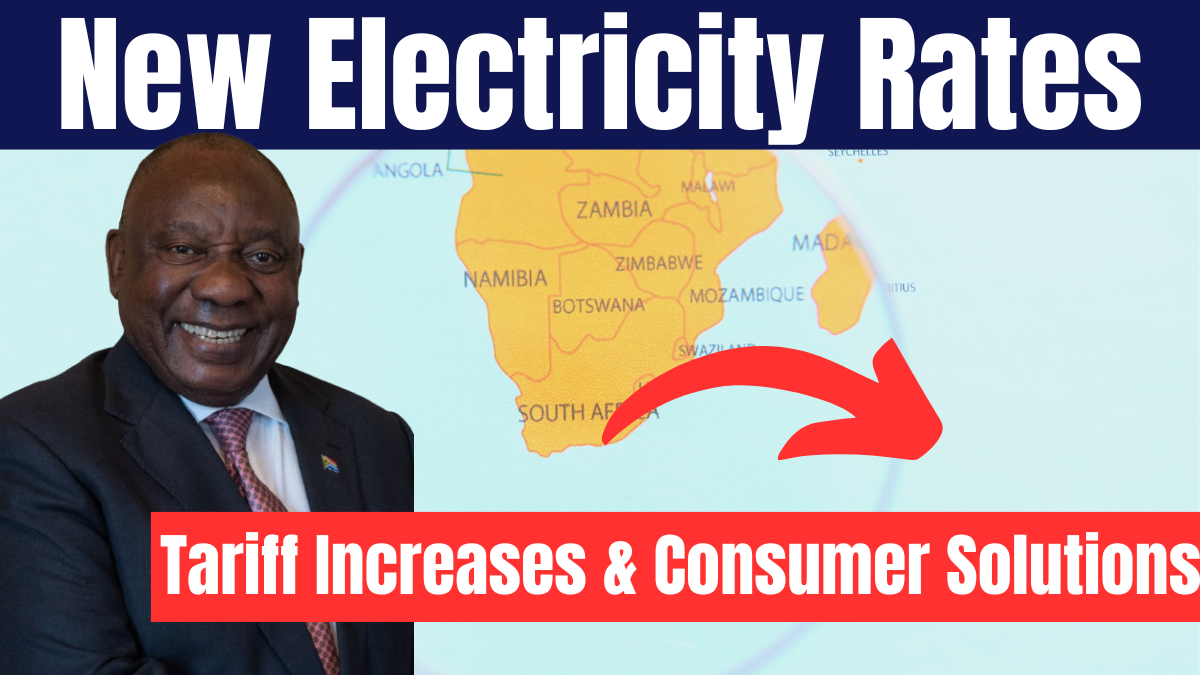South Africa is facing a significant electricity tariff increase in March 2025, with rates rising between 15% to 20% as approved by the National Energy Regulator of South Africa (NERSA). The tariff hike is primarily driven by the operational and financial challenges faced by Eskom, the state-owned electricity supplier.

Reasons Behind the Tariff Hike
- Infrastructure Maintenance: Funds are needed to repair and upgrade aging infrastructure.
- Operational Costs: Rising expenses in fuel, labor, and technology maintenance have increased Eskom’s operational costs.
- Energy Stability: To address load shedding and enhance power grid reliability, Eskom requires additional resources.
- Long-Term Investments: Financial support is essential for sustainable energy generation projects.
This increase is part of the government’s broader plan to stabilize the national power grid and reduce future energy shortages.
What Are the New Electricity Rates in South Africa for March 2025?
| Key Information | Details |
|---|---|
| Tariff Increase | 15% to 20% (as per NERSA approval) |
| Main Provider | Eskom (State-Owned Electricity Supplier) |
| Effective Date | March 2025 |
| Reason for Increase | Infrastructure maintenance, operational costs, and energy stability |
| Impact on Households | Higher monthly electricity bills, especially for high-consumption users |
| Impact on Businesses | Increased operating costs, particularly in energy-intensive sectors |
| Consumer Solutions | Energy efficiency, solar power adoption, and reduced consumption |
| Official Website | nersa.org.za |
Extent of the Tariff Hike:
- Residential Users: 15% to 18% increase depending on consumption.
- Commercial Users: Up to 20% for high-energy consumers.
- Rural Areas: Slight variations due to regional supply differences.
Consumers should anticipate higher electricity bills starting March 2025, with the final rates varying by region and usage patterns.
How Will the Tariff Increase Impact Households?
1. Effect on Households:
- Families will experience noticeable increases in their monthly electricity bills.
- High-consumption households, particularly those using electric heating or cooling, will feel the impact more.
- Low-income households may qualify for government support programs but will still face financial challenges.
| Household Consumption Level | Previous Monthly Cost (₱) | New Monthly Cost (₱) | Increase (%) |
|---|---|---|---|
| Low (100 kWh/month) | ₱250 | ₱288 | 15.2% |
| Medium (350 kWh/month) | ₱875 | ₱1,030 | 17.7% |
| High (600 kWh/month) | ₱1,500 | ₱1,785 | 19% |
What Is the Impact on Businesses and Industries?
2. Effect on Businesses:
- Small and medium-sized enterprises (SMEs) will face increased operational costs, which could affect profitability.
- Energy-intensive sectors (e.g., manufacturing, agriculture, and mining) will experience substantial financial pressure.
- Businesses may adjust product prices or cut expenses to offset rising energy costs.
| Business Type | Previous Energy Cost (₱/Month) | New Cost (₱/Month) | Increase (%) |
|---|---|---|---|
| Retail Store | ₱5,000 | ₱5,900 | 18% |
| Manufacturing Plant | ₱75,000 | ₱90,000 | 20% |
| Agricultural Facility | ₱12,500 | ₱14,750 | 18% |
| Office Building (SME) | ₱9,000 | ₱10,800 | 20% |
Businesses will need to reassess budgets and explore alternative energy solutions to manage costs effectively.
What Can Consumers Do to Manage Higher Electricity Costs?
1. Reduce Electricity Consumption:
Consumers should adopt energy-saving measures to mitigate the financial impact:
- Use energy-efficient appliances (e.g., LED bulbs, inverter air conditioners).
- Turn off devices when not in use and unplug chargers to avoid phantom power consumption.
- Install smart energy management systems to monitor and reduce usage.
2. Switch to Renewable Energy Sources:
To lessen dependence on Eskom, households and businesses can:
- Install solar panels to generate electricity and reduce monthly bills.
- Explore options for wind and biomass energy where feasible.
- Take advantage of government incentives for adopting clean energy solutions.
| Energy-Saving Solution | Estimated Cost (₱) | Potential Monthly Savings (₱) |
|---|---|---|
| Solar Panel Installation | ₱70,000 – ₱150,000 | ₱500 – ₱1,500 |
| Energy-Efficient Appliances | ₱2,000 – ₱10,000 | ₱200 – ₱500 |
| Smart Thermostats | ₱3,500 – ₱8,000 | ₱250 – ₱600 |
3. Advocate for Fair Energy Policies:
Consumers can:
- Voice concerns to NERSA and local representatives.
- Join community groups advocating for transparent energy pricing.
- Participate in public forums to push for better energy policies and grid improvements.
FAQs
Why are electricity tariffs increasing in South Africa in March 2025?
The tariff increase is due to Eskom’s rising operational costs, infrastructure repairs, and efforts to stabilize the national power grid.
How much will my electricity bill increase?
Bills are expected to increase between 15% to 20%, depending on your consumption and location.
Who approved the tariff hike?
The National Energy Regulator of South Africa (NERSA) approved the new rates after evaluating Eskom’s financial needs.
Will low-income households receive any support?
Yes, the government plans to offer subsidies and relief programs for eligible low-income households.
How can I reduce my electricity consumption?
Use energy-efficient appliances, turn off unused devices, and consider renewable energy options like solar panels.
Click here to know more.
Aanchal is a passionate writer with a keen interest in storytelling, content creation, and creative expression. She enjoys exploring diverse topics and crafting engaging narratives that captivate readers.